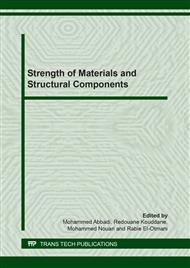p.118
p.128
p.137
p.147
p.159
p.173
p.179
p.188
p.203
Prediction of the Lifetime of Acrylonitrile Butadiene Styrene (ABS), by Calculation of Damage by Two Methods: Damage Based on Residual Stresses and Damage by Stages Evolution
Abstract:
The development of polymers has not stopped growing and taking more and more emphasis in our lives. From high-performance industries to mass-market industries, polymers are ubiquitous in every aspect of our lives, from where comes the pressing need to know their properties, characteristics, and behaviors more rigorously. This work is based on a study of the mechanical characterizations of thermoplastic polymers under the effects of damage. To serve this purpose, an experimental study was carried out on thermoplastic ABS (Acrylonitrile Butadiene Styrene) specimens. At first, we worked on altered specimens to define the mechanical characteristics of our material such as the elastic limit, the stress maximum, the breaking stress and the Young's modulus. On the one hand, and on the other hand we have created geometrical defects (discontinuity) on specimens in (ABS), to have the effect of defects on the mechanical characteristics of the material, afterwards a study of damage carried out by two methods to determine the critical fraction of life. To determine the lifetime of the ABS.
Info:
Periodical:
Pages:
203-211
Citation:
Online since:
September 2019
Keywords:
Price:
Сopyright:
© 2019 Trans Tech Publications Ltd. All Rights Reserved
Share:
Citation:


